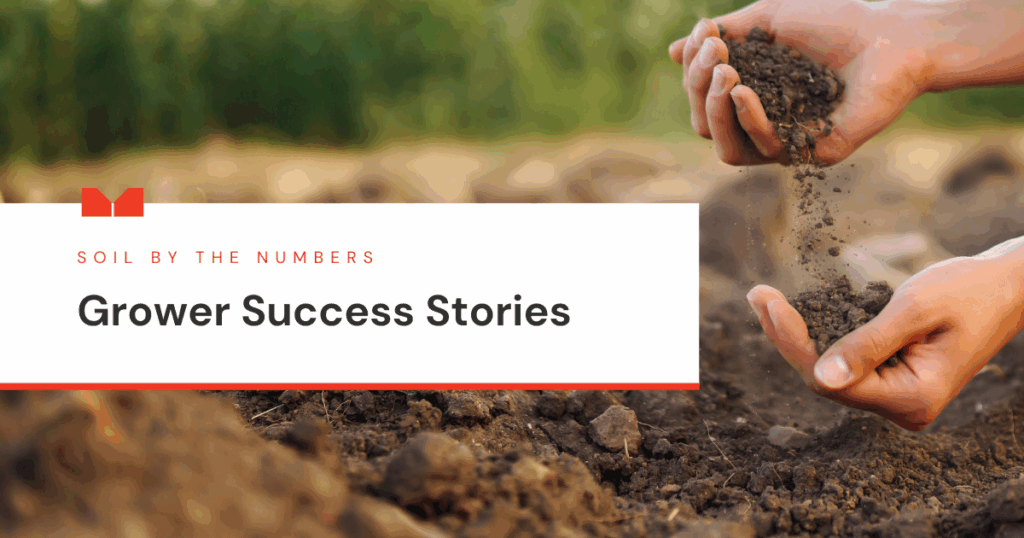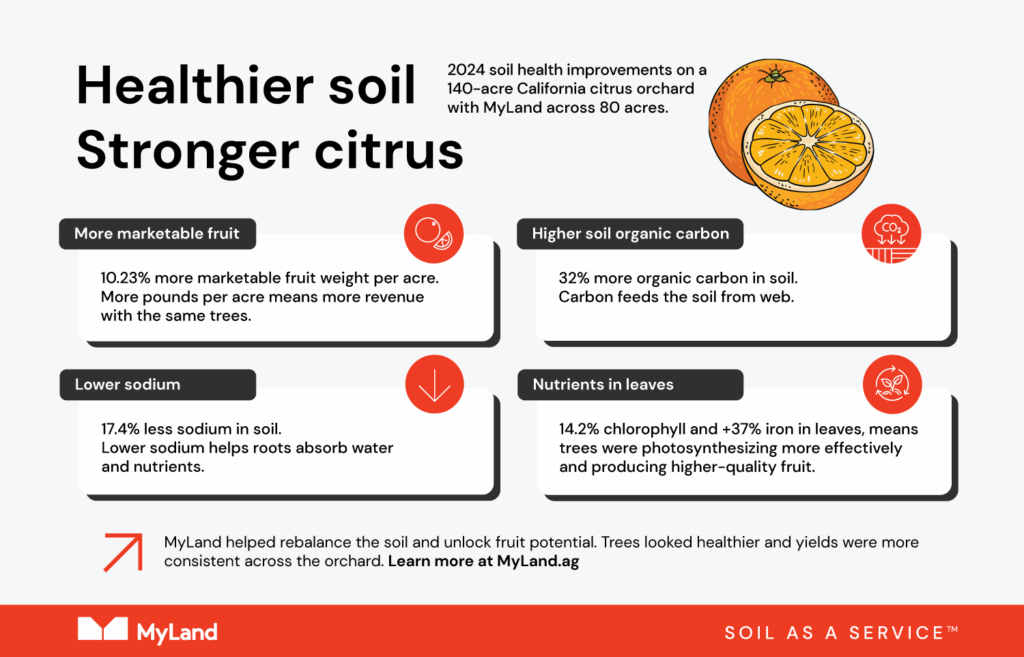
Healthy Soil to Healthy Profits: 2024 Grower Success Stories
In 2024, MyLand delivered big results for soil health, crop quality, and farm success.
Last year brought standout success for farms using MyLand’s Soil as a Service™. From pistachio orchards to potato fields, 2024 delivered measurable improvements that made a difference for farmers: healthier soil, better crops, and stronger returns.
By adding live, native microalgae back into their soil, growers didn’t just treat symptoms; they rebuilt the biological foundation of their land. Healthy soil depends on a balance of biological life, chemical nutrients like nitrogen and phosphorus, and physical structure (like soil texture and compaction). When all three work together, crops grow stronger, land becomes more resilient, and growers are more successful.
The results highlighted in this post come from studies done by Contract Research Organizations (CROs). CROs are independent, third-party entities that generate objective, verifiable data. In addition to these studies, we’ve also included grower-reported data, which provides valuable, real-world insights from the field. This combination of third-party data and firsthand grower reporting paints a holistic picture of how MyLand is helping farmers succeed.
Let’s take a closer look at these amazing results, crop by crop.
California pistachio farm: More nuts, happier trees
Farm Profile: 900-acre operation using MyLand across 454 acres.
This Central Valley pistachio grower was dealing with all the usual headaches: drought, tight watering schedules, and soil that had lost microbial activity. MyLand helped turn things around.
- +29% increased soil respiration1
- More soil respiration means more microbial activity. Soil respiration measures the carbon dioxide released by microbes and plant roots. When these numbers are higher, it shows that the soil is more alive. Soil respiration has other benefits too, like improving the soil structure and making nutrients available to plants.
- The farm’s soil health score jumped from 3 to 81
- This jump was measured using the Haney Test (check out our webinar featuring the creator of the test, Dr. Rick Haney) — a widely used tool that looks at the biological and chemical makeup of soil. The soil health score combines factors like microbial activity, available nutrients, and organic carbon.
A score of 3 suggests low-functioning soil, while a score of 8 reflects vibrant microbial life, better nutrient cycling, and soil that supports strong plant growth.
- 168% increase in harvested nuts1
- MyLand-serviced trees produced 593 lbs per acre while the control produced 221 lbs per acre, nearly a 3x increase during an alt-bearing year.
- Tree water stress dropped by 50%, while tree growth per inch of water improved by 39%2
- The farm’s trees were under less pressure in 2024 and got more growth out of each drop of water — a major advantage when water is limited and expensive.
This California grower reported fewer signs of stress in the orchard, faster nut development, and more consistent yields on MyLand Serviced acres.
Washington apple farm: Bigger harvests, longer storage
Farm Profile: 193-acre orchard with MyLand on 40 of its acres.
Apples need to stay firm from the field to the store. This orchard improved both yield and post-harvest quality with the MyLand Service.
- +8% yield in 2023, +28% in 20248, 9
- Apple yield gains kept compounding as soil health improved.
- 5X return on investment for two years in a row8
- Smart soil management delivered strong financial results.
- +8% firmness at harvest, +4% after six weeks in storage8
- Higher quality and longer shelf life leads to more marketable products.
“Our grower was looking for a way to increase yield on an orchard that had developed soil and disease issues. The first two years showed the MyLand Service led to an increase of 5 bins per acre over the control, better quality in storage, and improved soil health. They’re pleased with a 5.1x ROI for both years, and we are continuing the study focused on apple storage and marketable yield,” said Thad Schutt, MyLand Regional Sales Manager.
This Washington apple grower reported fewer storage losses and a healthier appearance on arrival to buyers. This data strengthened MyLand’s relationship with the apple grower and helped to pave the way for an additional study focused on apple storage, quality, and marketable yield.
Washington potato farm: Bigger potatoes, better payouts
Farm Profile: 320-acre farm with MyLand on 160 acres.
In a region known for potato perfection, this farm used the MyLand Service to make the most out of every acre.
- +14.3% yield = $935.46 more per acre3
- The grower attributed these gains in part to improvements in soil health and crop consistency supported by MyLand’s Service.
- 3.7X return on investment3, 9
- Every dollar spent on MyLand returned $3.70 (and that’s not even counting the benefits to long-term soil health).
- Potatoes were 11% longer and 8% wider3
- Bigger spuds reduce sorting and improve market value.
- 3% drop in sugar content3
- Lower sugar means less browning during frying. That translates to better-looking fries and fewer quality downgrades.
This farm saw more uniform rows, healthier foliage, and less variation between fields — signs that soil biology was doing its job.
California tomato farm: Stress-proof plants and longer shelf life
Farm Profile: 77.5-acre tomato farm using MyLand in 2024.
Tomatoes are sensitive: too much heat or inconsistent watering can ruin a season. This grower leaned on MyLand to build resilience into their plants and soil.
- 11% more chlorophyll mid-season4
- Chlorophyll fuels photosynthesis. More of it during a stressful part of the season means plants can keep producing even in extreme heat.
- Fruit weight up 8.5%, yield up 2.5%4
- Heavier tomatoes equal more product per acre, and a stronger yield helps offset costs.
- +3.7% firmness, +5.6% weight after 10 days4
- Firmer fruit lasts longer and holds up better in transport.
- 14% fewer unmarketable tomatoes after 15 days4
- Less waste means more tomatoes are able to be stored on shelves, thereby increasing profits for farmers.
- Soil showed more beneficial fungi, Bacillus spp., and stress-tolerant microbes5
- These microbes support root health and help plants handle extreme conditions. This is one example of how improving the biological properties of soil helps improve plant performance. When paired with more balanced soil chemistry and better physical soil structure, the benefits multiply. MyLand makes it easier for those natural systems to thrive.
This California tomato grower noted more uniform ripening and improved shelf life — both critical for shipping to retailers.
California citrus farm: Healthier soil, stronger fruit
Farm Profile: 140-acre citrus orchard with 80 acres using the MyLand Service.
High sodium and low organic matter were causing this citrus farm to struggle. MyLand helped rebalance the soil and unlock fruit potential.
- +10.23% marketable fruit weight per acre6
- More pounds per acre gives growers more revenue with the same trees.
- –17.4% sodium in soil6
- Lower soil sodium helps roots absorb water and nutrients more effectively.
- +32% organic carbon in soil6
- Carbon feeds the soil food web, supporting microbes that break down nutrients and improve soil texture.
- +14.29% chlorophyll and +37% iron in leaves6
- These gains meant trees were photosynthesizing more effectively and producing higher-quality fruit.
On this citrus orchard, the trees looked healthier, and the yields were more consistent.

California almond farm: Strong results from season one
Farm Profile: 436-acre orchard used MyLand on a portion of its acreage in 2024.
- +6% marketable yield = 144 lbs/acre 7, 9
- This increase reflects estimated improvements in almond output based on grower records. Exact pricing can vary, but the added weight per acre signals strong early gains.
- 1.3X return on investment; over $150,000 in added value across MyLand serviced fields 7, 9
- This number points to strong early signs that healthy soil leads to healthy profits (just like this MyLand farmer).
This California almond grower noticed better nut fill on their MyLand serviced acres.
Let your biology do the work
In 2024, growers using MyLand’s Soil as a Service™ saw real results: better yields, stronger crops, and smarter water use.
These weren’t small wins: they were big leaps powered by biology, chemistry, and the physical properties of healthy soil coming together underground.
Ready to see the benefits from healthier soil on your farm? Reach out to our team today.
Explore MyLand grower stories:
- Improving Water Efficiency and Soil Health for Ed Curry’s Arizona Chili Pepper Farm
- Enhancing Soil Health on Beckwith Farms
- Joe Coelho on Soil Health and Sustainability in California’s Central Valley
Footnotes
- Grower-supplied yield and respiration data, CA pistachio trial, 2024
- Phytech irrigation monitoring, CA pistachio trial, 2024
- CRO data, WA potato trial, 2023
- Chlorophyll and fruit quality data, CA tomato trial, 2024
- BE Crop soil genetic analysis, CA tomato trial, 2024
- Soil and leaf tissue testing, CA citrus trial, 2024
- Yield estimate and pricing calculation, CA almond trial, 2024
- Grower-supplied yield and firmness data, WA apple trial, 2023–2024
- ROI data represents an increase in revenue from yield increase; potential additional increase in ROI from more efficient use of inputs and water.